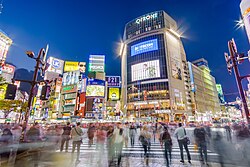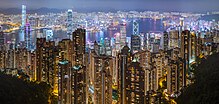
Back Ақалақь Abkhazian Stad Afrikaans Stadt ALS ከተማ Amharic Tokayto AMI Ciudat AN Burg ANG مدينة Arabic ܡܕܝܢܬܐ ARC مدينة ARY
A city is a human settlement of a substantial size. The term "city" has different meanings around the world and in some places the settlement can be very small. Even where the term is limited to larger settlements, there is no universally agreed definition of the lower boundary for their size.[1][2] In a narrower sense, a city can be defined as a permanent and densely populated place with administratively defined boundaries whose members work primarily on non-agricultural tasks.[3] Cities generally have extensive systems for housing, transportation, sanitation, utilities, land use, production of goods, and communication.[4][5] Their density facilitates interaction between people, government organizations, and businesses, sometimes benefiting different parties in the process, such as improving the efficiency of goods and service distribution.
Historically, city dwellers have been a small proportion of humanity overall, but following two centuries of unprecedented and rapid urbanization, more than half of the world population now lives in cities, which has had profound consequences for global sustainability.[6][7][8][9][10] Present-day cities usually form the core of larger metropolitan areas and urban areas—creating numerous commuters traveling toward city centres for employment, entertainment, and education. However, in a world of intensifying globalization, all cities are to varying degrees also connected globally beyond these regions. This increased influence means that cities also have significant influences on global issues, such as sustainable development, climate change, and global health. Because of these major influences on global issues, the international community has prioritized investment in sustainable cities through Sustainable Development Goal 11. Due to the efficiency of transportation and the smaller land consumption, dense cities hold the potential to have a smaller ecological footprint per inhabitant than more sparsely populated areas.[11][12] Therefore, compact cities are often referred to as a crucial element in fighting climate change.[13][14][15] However, this concentration can also have some significant harmful effects, such as forming urban heat islands, concentrating pollution, and stressing water supplies and other resources.
- ^ Goodall, B. (1987). The Penguin Dictionary of Human Geography. London: Penguin.
- ^ Kuper, A.; Kuper, J., eds. (1996). The Social Science Encyclopedia (2nd ed.). London: Routledge.
- ^ Caves, R. W. (2004). Encyclopedia of the City. Routledge. p. 99.
- ^ Glaeser, Edward (2011). "Cities, Productivity, and Quality of Life". Science. 333 (6042): 592–594. Bibcode:2011Sci...333..592G. doi:10.1126/science.1209264. ISSN 0036-8075. PMID 21798941. S2CID 998870.
- ^ Bettencourt, Luis; West, Geoffrey (2010). "A unified theory of urban living". Nature. 467 (7318): 912–913. Bibcode:2010Natur.467..912B. doi:10.1038/467912a. PMID 20962823.
- ^ Ritchie, Hannah; Roser, Max (13 June 2018). "Urbanization". Our World in Data. Archived from the original on 29 October 2020. Retrieved 14 February 2021.
- ^ James, Paul; with Magee, Liam; Scerri, Andy; Steger, Manfred B. (2015). Urban Sustainability in Theory and Practice: Circles of Sustainability. London: Routledge. ISBN 978-1315765747. Archived from the original on 1 March 2020. Retrieved 20 December 2017.
- ^ "Rise of the City". Science. 352 (6288): 906–907. 2016. doi:10.1126/science.352.6288.906. PMID 27199408.
- ^ "Cities: The century of the city". Nature. 467 (7318): 900–901. 2010. doi:10.1038/467900a. PMID 20962819.
- ^ Sun, Liqun; Chen, Ji; Li, Qinglan; Huang, Dian (2020). "Dramatic uneven urbanization of large cities throughout the world in recent decades". Nature Communications. 11 (1): 5366. Bibcode:2020NatCo..11.5366S. doi:10.1038/s41467-020-19158-1. PMC 7584620. PMID 33097712.
- ^ "Cities: a 'cause of and solution to' climate change". UN News. 18 September 2019. Archived from the original on 4 March 2021. Retrieved 20 March 2021.
- ^ Merite, Gabrielle; Vitorio, Andre. "How megacities could lead the fight against climate change". MIT Technology Review.
- ^ "Sustainable cities must be compact and high-density". The Guardian. 30 June 2011. Archived from the original on 9 March 2021. Retrieved 20 March 2021.
- ^ Angelo, Hillary; Wachsmuth, David (2020). "Why does everyone think cities can save the planet?". Urban Studies. 57 (11): 2201–2221. Bibcode:2020UrbSt..57.2201A. doi:10.1177/0042098020919081.
- ^ Bibri, Simon Elias; Krogstie, John; Kärrholm, Mattias (2020). "Compact city planning and development: Emerging practices and strategies for achieving the goals of sustainability". Developments in the Built Environment. 4: 100021. doi:10.1016/j.dibe.2020.100021. hdl:11250/2995024.







